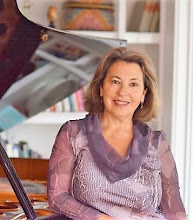I have many "sayings" that I find myself repeating over and over again to my students. Although all my students are dedicated, and believe in my methods, and do strive to put my instructions into their practice, nevertheless, people tend to fall back on old habits, often without even realizing it.
And sometimes they do realize they are falling back on old habits but somehow still hope they are going to work this time.
Here are the most stubborn habits.
"Correcting" a wrong note immediately. I've written about this in several previous posts. It's so automatic, like a knee-jerk reaction, to want to do this. Let's say you played an F when the note should have been an F-sharp. You may think that immediately playing the F-sharp after the F will solve the problem. But sure enough, the same thing happens the next time. And the next. Your intellect may know that you intend to play the F-sharp from now on, but the "animal" brain has heard and experienced F immediately followed by F-sharp and just "thinks" that 2-note combination is how it's supposed to be, because that is what it heard and what it experienced. Many teachers (and things you will read) tell you that you must "correct" the wrong note immediately because otherwise it will become permanent. However, you'll find that experience doesn't bear that out. It's very difficult for many people to change this habit. Even if they understand that it doesn't work, they still cling to the idea that playing the right note after the wrong note will fix the problem. To which I say "if it really worked, you'd already have it by now." (For how to successfully correct wrong notes, see my post of that title.)
Looking at your hands while reading new music from a written score. Many people would assume they have to look at their hands to "find the notes." However, it is the exact opposite of what you need to do to achieve any meaningful level of mastery. The hands have to learn to find their way. In complex music there would be no way to find all the notes by sight. There is just too much going on with two hands, especially if it is fast. If you look at your hands, you'll bypass kinesthetic skill-building. My students are trying not to look at their hands, but when the going gets tough, sure enough, they start looking at the keyboard. It usually doesn't work at all, because it causes a delay, at which time the other hand has to pause, leading to more problems. So often I see a student look down to find the note(s) and they still miss it. At which point I say "if it really worked, you'd already have it by now."
Playing hands separately. Clearly, the singular challenge of the piano is that two hands must be doing two different things at the same time, and often both hands have complex parts to play. I want my students to be playing hands together 95% of the time. The way to work up to this is to play an outline, or a sketch, of the piece, omitting notes as necessary but attempting to play enough that you can hear the "bones" of the piece, and most importantly, keep going and not stop. (See earlier posts on Outlining.) Then you keep adding more details until you have it all. You still may need to do some "spot work" on more difficult passages. But I have found that when they get frustrated, students tend to fall back on playing hands separately, the idea being if they get each hand really solid, it will be easier to put them together. Guess what -- it isn't!! Playing the hands together is a whole different experience and requires that the brain work differently than one hand at a time. When a student gets frustrated that the piece is not progressing as well as they hoped, they "confess" at the lesson that they did a lot of hands separately at home. But when they do try to play it together, it isn't any better. And of course I say, "if it really worked, you'd already have it by now."
The piano is challenging, and a student still somewhat new to the instrument probably has many misconceptions about how to practice and how to learn. One of the main reasons that trying to teach yourself is usually a dead-end is because nothing teaches you how to practice. That is why you need a skilled and insightful teacher. If you're practicing in a way that you think makes sense but not getting results, you probably can assume it's what you're doing in your practice, not just a lack of ability. When you find yourself doing something over and over, and it's not improving, ask yourself: "If it really worked, wouldn't I have it by now?"
